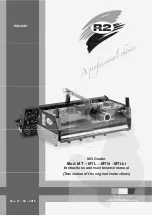
14
Copyright Safewaze 2022
3) Review the user instructions
and the measurement parameters
marked on the side of the gauge.
(See Fig.7)
Follow Warnings and Instructions
≥1.0mm (.039”)Edge
.05mm (.002”)
+
≥1.0mm (.039”)Edge
.05mm (.002”)
+
FIGURE 13
4) Firmly place the Sub-Edge Gauge
on the edge requiring inspection. Any
edge measuring out at 1.0 mm or
greater is acceptable. If an edge has
a smaller radius than the allowed 1.0
mm, the Sub-Edge Gauge will not
properly fit. In any cases where the
radius is smaller than the alllowable
amount, this system must not be
used. (See Fig.8) For use on
WOOD
EDGES
ONLY
! Misuse of this system
could result in serious injury or death.
These instructions must be provided
to the user of this equipment.
Follow Warnings and Instructions
≥1.0mm (.039”)Edge
.05mm (.002”)
+
Follow Warnings and Instructions
≥1.0mm (.039”)Edge
.05mm (.002”)
+
Follow Warnings and I
nstructions
≥1.0mm (.039”)Edge
.05mm (.002”)
+
FIGURE 14
Follow Warnings and Instructions
≥1.0mm (.039”)Edge
.05mm (.002”)
+
WARNING:
For proper operation, installation,
maintenance and servicing, refer to these User
Instructions including all manufacturer
recommendations, see your supervisor, or
contact Safewaze. Minimize swing falls by
working as directly below the anchorage point
as possible.
Hazards:
Use of this equipment in areas where
surrounding hazards exist may require additional
precautions to reduce the possibility of injury to
the user or damage to equipment. Hazards may include,
but are not limited to: high heat, caustic chemicals, corrosive
environments, high voltage power lines, explosive or toxic gases,
moving machinery, or overhead materials that may fall and
contact the user or fall arrest system. Avoid working where your
lifeline may cross or tangle with that of another worker. Avoid
working where an object may fall and strike the lifeline; resulting
in loss of balance or damage to the lifeline. Do not allow the
lifeline to pass under arms or between legs.
Using Retractable Devices - Clearance Chart
Table 2 indicates the required clearance from the walking/working surface to the ground or nearest obstruction
below, when using retractable devices. Intermediate anchorage connectors may be added to a system to help
reduce span length and allow for lower fall clearances.
*Distance from walking/working surface. Clearances
are calculated using only the SafeLink Horizontal
Lifeline System, fully assembled per the User Manual.
SAFELINK—CLEARANCE REQUIREMENTS
14
NOTE: If 12 in (304.8 mm) D-Ring Extender is used, an
additional distance of 12 in (304.8 mm) must be added to
the above clearance height requirements. DO NOT attach
fixed-length lanyard equipment to this system.
15 Feet
7'0"
7'0"
7'0"
7'6"
20 Feet
7'0"
7'0"
7'4"
7'8"
25 Feet
7'0"
7'4"
8'0"
8'4"
30 Feet
7'0"
7'8"
8'4"
8'8"
35 Feet
7'9"
8'5"
9'1"
9'5"
40 Feet
8'5"
9'1"
9'9"
10'2"
45 Feet
9'2"
9'11"
10'8"
11'0"
50 Feet
9'11"
10'7"
11'3"
11'8"
55 Feet
10'6" 11'2"
12'0"
12'4"
60 Feet
10'10" 11'10"
12'6"
12'11"
65 Feet
11'10"
12'6"
13'0"
13'6"
Lifeline
Span
1 User
Minimum
Clearance
Required
2 Users
Minimum
Clearance
Required
3 Users
Minimum
Clearance
Required
4 Users
Minimum
Clearance
Required
Fig. 7
Fig. 8
Table 2







































